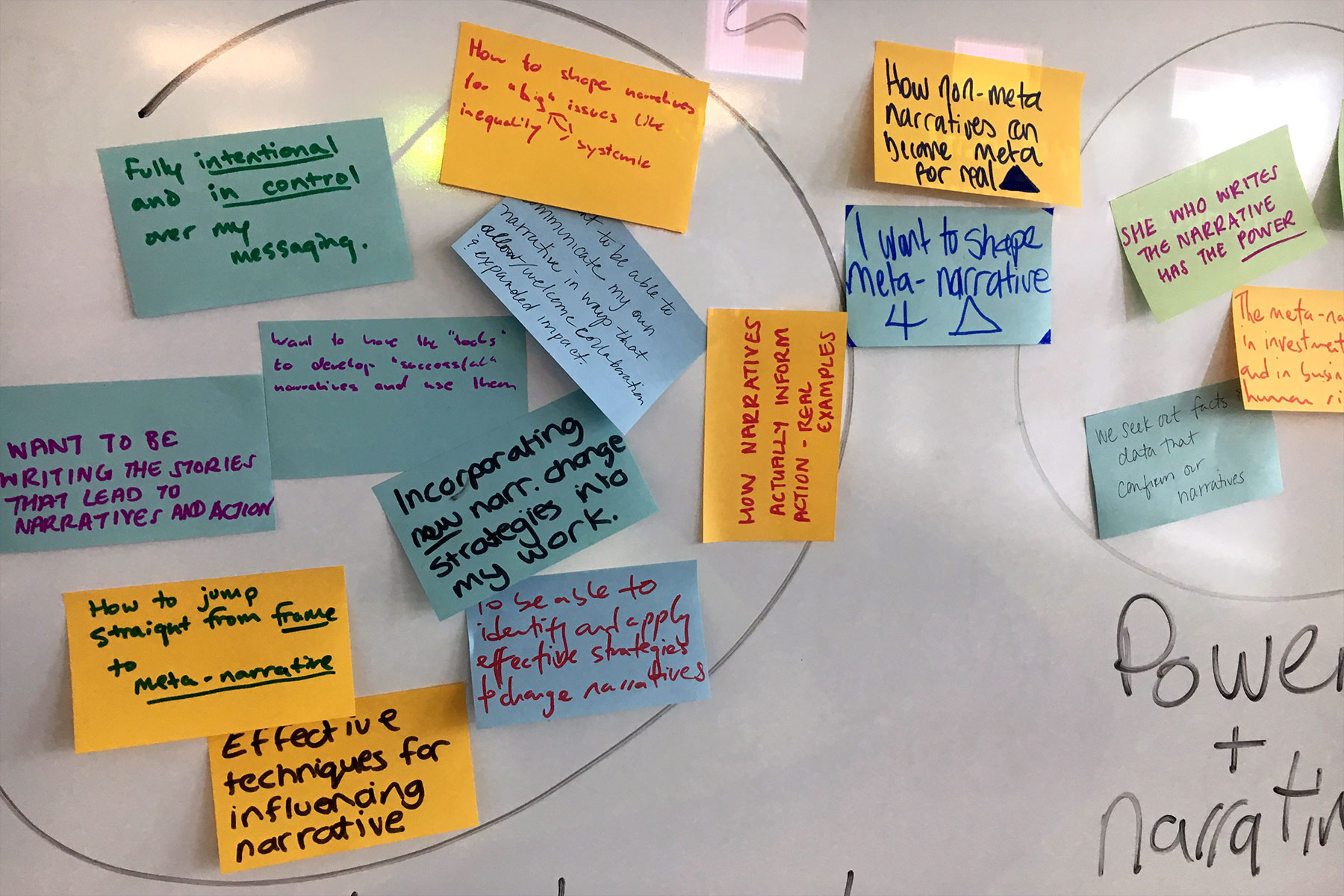Narrative Change: A Working Definition (and Some Related Terms)
Starting in 2016, Narrative Initiative began gathering up different ways people talk about narrative change, how it’s structured, and how it moves in the world. As our staff—a team experienced in capacity building, organizing, communications, philosophy and culture work—engage partners and practitioners, we’ve found it helpful to highlight existing terms in use and offer shared terminology where we identify gaps.
Narrative change is a practice that draws on many different disciplines. Some have well established standards, like the legal profession. Others, digital organizing for instance, rely on an evolving set of practices to get the job done. We and many others are doing the work of “narrative change” every day and, depending on where we’re coming from, we talk about it in many, many different ways.
Want to know more? Read these articles: Recent posts about narrative practice and projects.
+ Four Baskets: Necessary capacities for narrative change
+ Waves: A model for deep narrative change
+ A big narrative change reading list
This shared language is alive and evolving. Is there language you’ve used in group or coalition spaces that has helped people understand narrative better? Tell us your stories and share your comments with us.
What is Narrative Change?
A narrative reflects a shared interpretation of how the world works. Narrative change, writes Brett Davidson, “rests on the premise that reality is socially constructed through narrative, and that in order to bring about change in the world we need to pay attention to the ways in which this takes place.” At Narrative Initiative, we view narrative change work as integral to movement work. Enduring and impactful social change moves at the speed of narrative.
Narrative Concepts
These core concepts articulate the different levels at which we engage with narrative specifically in the context of social change. Each category has discrete functions, expressions, and modes of transmission.
Story
A story describes an event or sequence of events that include characters, conflict, and imagery. It has a beginning, middle and end. (Toward New Gravity)
Narrative
Narratives are the ideas and themes that permeate collections of stories. The ideas can appear in any structure, and are articulated and refined repeatedly in a variety of stories and messages. (Toward New Gravity)
Deep Narrative
Deep narratives are the stickiest themes and ideas that have permeated stories for more than 50 years (Funding Narrative Change). They undergird collections of narratives and circumscribe how we make sense of our relationships to ourselves, others, and the broader world. They impact how we view power – who can exercise it, how, when, and for what purpose. Deep narratives comprise what we view as “common sense” or “natural.”
These foundational terms are interconnected and reinforce each other over time. Here is an example:
- The movie Jaws is a story about an insatiable man-eating shark
- All the stories about insatiable, man-eating sharks add up to a broader narrative that teaches us that sharks are dangerous and predatory creatures
- The narrative and stories about sharks rest on powerful deep narratives about the human relationship to nature and a fear of the unknown
This example was developed in partnership with Reframe Mentorship.
Key Capacities in Narrative Change Projects
Narrative Initiative has started to think about narrative change as involving four key capacities, or four ‘baskets’ that any successful narrative change project will have filled. These four baskets are based on our 2018 work with a set of global social justice fellowships and a large, U.S.-based coalition, as well as our experience with the diversity of approaches to narrative change practice.
Create
The creative act of generating a new narrative is an essential first step in narrative change practice. Early in the process, articulate both the new narrative you’re working to shift to and the existing, dominant one you’re trying to shift away from.
Translate
To effectively change a narrative, it is necessary to deploy a new one in the world. Effective deployment means a narrative is legible in many places, to many audiences. Identify audiences to connect with, and find ways to express the narrative that are meaningful to all the audiences who need to adopt it.
Drive
Move your narrative in public by designing effective narrative interventions. New narratives only become dominant when they are both put into practice and adopted widely.
Observe Together
Is your new narrative is being adopted? Understanding the larger narrative landscape is key to being effective. Mapping before/during/after sustained efforts of narrative shift shows what is working and where to improve practice. Watch the change happen with all of your stakeholders.
Our hope is that this high-level framework will enable us to think how various disciplines and lineages of practice might be brought to bear during a narrative change project.
Want to know more about the Four Baskets? Visit the Four Baskets article in our Constructing Gravity series to learn about the capacities needed and used to create, translate, drive and observe narrative together.

